key CHEVROLET TRACKER 1998 1.G Owner's Manual
[x] Cancel search | Manufacturer: CHEVROLET, Model Year: 1998, Model line: TRACKER, Model: CHEVROLET TRACKER 1998 1.GPages: 386, PDF Size: 21.17 MB
Page 120 of 386
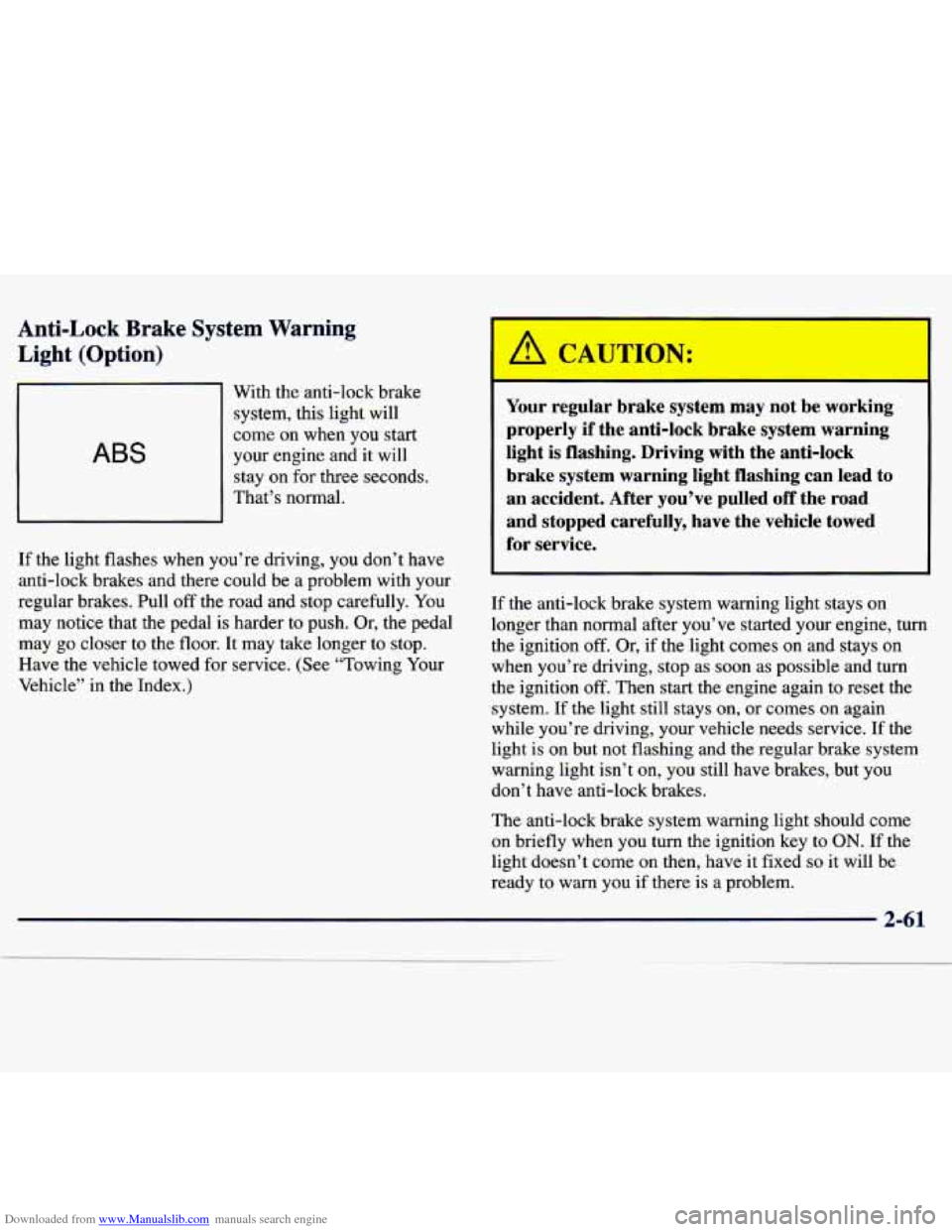
Downloaded from www.Manualslib.com manuals search engine Anti-Lock Brake System Warning
Light (Option)
ABS
With the anti-lock brake
system, this light will
come on when you start
your engine and it will
stay on for three seconds.
That’s normal.
If the light flashes when you’re driving, you don’t have
anti-lock brakes and there could be a problem with your
regular brakes. Pull
off the road and stop carefully. You
may notice that the pedal is harder to push. Or, the pedal
may
go closer to the floor. It may take longer to stop.
Have the vehicle towed for service. (See “Towing Your
Vehicle’’ in the Index.)
I
I h, CAUTION:
Your regular brake system may not be working
properly if the anti-lock brake system warning
light is flashing. Driving with the anti-lock
brake system warning light flashing can lead to an accident. After you’ve pulled off the road
and stopped carefully, have the vehicle towed
for service.
If the anti-lock brake system warning light stays on longer than normal after you’ve started your engine, turn
the ignition off. Or, if the light comes
on and stays on
when you’re driving, stop
as soon as possible and turn
the ignition off. Then start the engine again to reset the
system.
If the light still stays on, or comes on again
while you’re driving, your vehicle needs service. If the
light is on but not flashing and the regular brake system
warning light isn’t on, you still have brakes, but
you
don’t have anti-lock brakes.
The anti-lock brake system warning light should come
on briefly when you turn the ignition key to
ON. If the
light doesn’t come on
then, have it fixed so it will be
ready to warn you
if there is a problem.
Page 121 of 386
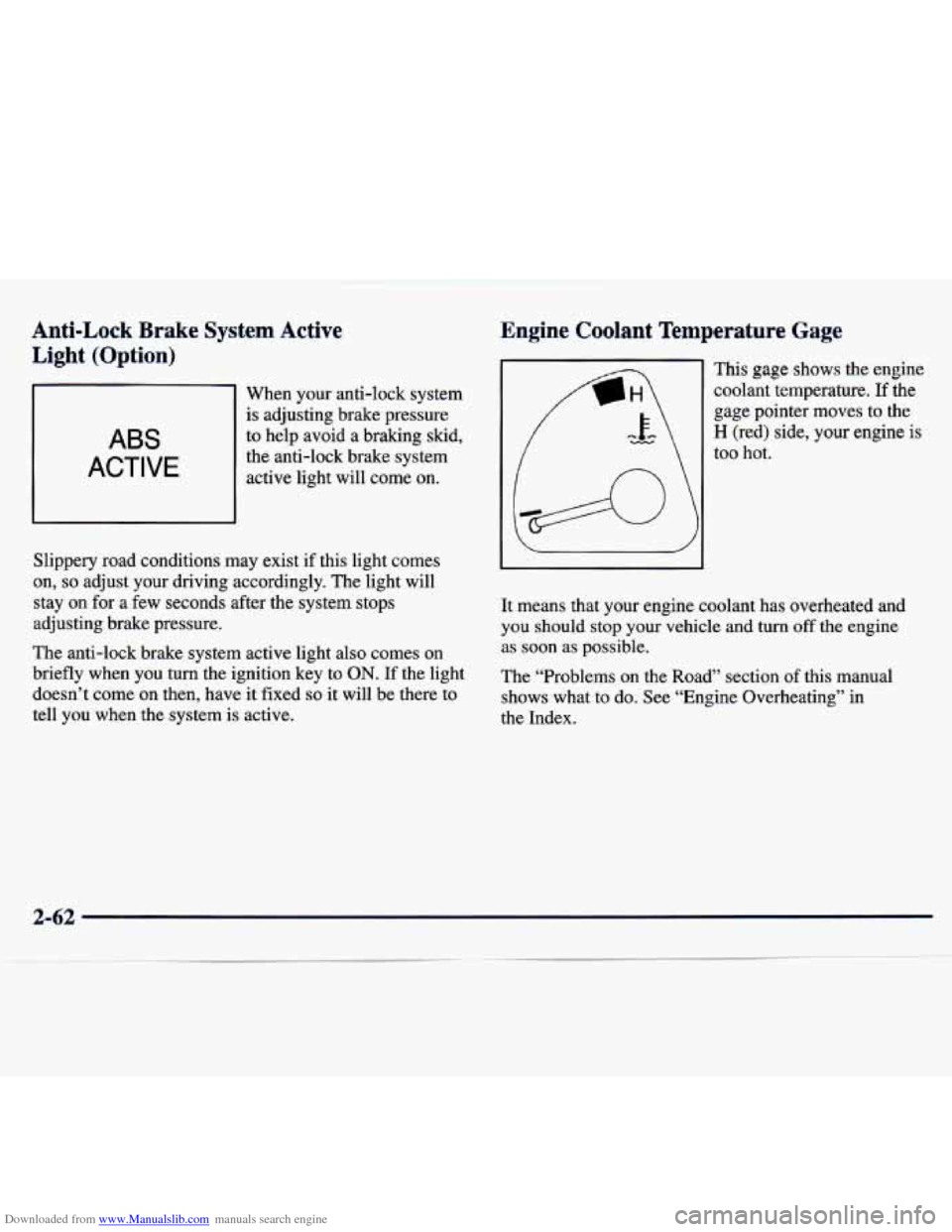
Downloaded from www.Manualslib.com manuals search engine Anti-Lock Brake System Active
Light (Option)
~
._.a
Engine Coolant Temperature Gage
ABS
ACTIVE
r 1
When your anti-lock system is adjusting brake pressure
to help avoid a braking skid,
the anti-lock brake system active light will come on.
Slippery road conditions may exist if this light comes
on,
so adjust your driving accordingly. The light will
stay on for a few seconds after the system stops
adjusting brake pressure.
The anti-lock brake system active light also comes on
briefly when you turn the ignition key to
ON. If the light
doesn’t come on then, have it fixed
so it will be there to
tell you when the system is active. This
gage shows the engine
coolant temperature. If the
gage pointer moves to the
H (red) side, your engine is
too hot.
It means that your engine coolant has overheated and
you should stop your vehicle and
turn off the engine
as soon as possible.
The “Problems on the Road” section of this manual
shows what to do. See “Engine Overheating’’ in
the Index.
2-62
Page 123 of 386

Downloaded from www.Manualslib.com manuals search engine If the Light Is Flashing
The following may prevent more serious damage to
your vehicle:
Reducing vehicle speed.
0 Avoiding hard accelerations.
Avoiding steep uphill grades.
If the Light Is On Steady
If you are towing a trailer, reduce the amount of
cargo being hauled as soon as it is possible.
If the light stops flashing and remains on steady, see
“If
the Light Is On Steady’’ following.
If the light continues to flash, when it is safe to do so,
stop the vehicle. Find a safe place to park your vehicle.
Turn the key off, wait at least 10 seconds and restart the
engine. If the light remains on steady, see “If the Light
Is On Steady’’ following. If the light is still flashing,
follow the previous steps, and drive the vehicle to your
dealer or qualified service center for service.
You may be able to correct the emission system
malfunction by considering the following:
Did you recently put fuel into your vehicle?
If so, reinstall the fuel cap, making sure to fully install
the cap. The diagnostic system can determine if the fuel
cap has been left
off or improperly installed. A loose or
missing fuel cap will allow fuel to evaporate into the
atmosphere.
A few driving trips with the cap properly
installed should
turn the light off.
Did you just drive through a deep puddle of water?
If so, your electrical system may be wet. The condition
will usually be corrected when the electrical system
dries out. A few driving trips should
turn the light off.
Are you low on fuel?
As your engine starts to run out of fuel, your engine may
not run as efficiently as designed since small amounts of
air are sucked into the fuel line causing a misfire. The
system can detect
this. Adding fuel should correct this
condition. Make sure to install the fuel cap properly. It
will take a few driving trips to turn the light
off.
j
2-64
I
~ i
I
Page 125 of 386

Downloaded from www.Manualslib.com manuals search engine Don’t keep driving if the oil pressure is low. If
you do, your engine can become so hot that it
catches fire. You or others could be burned.
Check your oil
as soon as possible and have
your vehicle serviced.
I NOTICE:
Damage to your engine from neglected oil
problems can be costly and is not covered by
your warranty.
Power Indicator Light (If Equipped)
POWER
This light comes on when
the power mode selector
switch is turned to
POWER
(P) with the
ignition switch in the
ON position.
This light comes on as a check for approximately
5 seconds when the ignition key is turned to ON
or START.
Overdrive Off Light (If Equipped)
O/D OFF
This light comes on when
the automatic four-speed
transmission has been
converted to the three-speed
mode and the overdrive is
turned
off.
This light also comes on as a check for approximately
5 seconds when the ignition key is turned to ON
or STmT.
2-66
Page 148 of 386
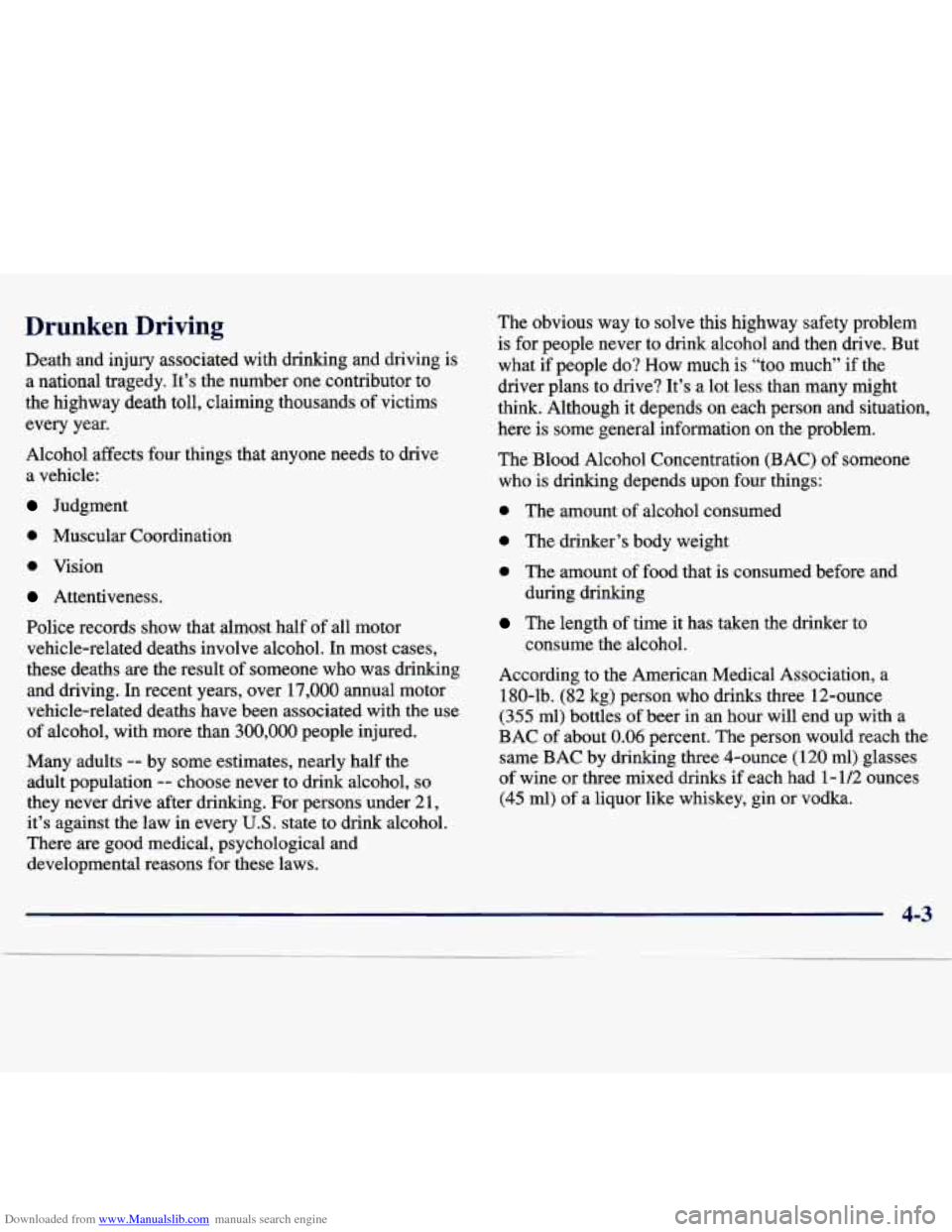
Downloaded from www.Manualslib.com manuals search engine Drunken Driving
Death and injury associated with drinking and driving is
a national tragedy. It’s the number one contributor to
the highway death toll, claiming thousands of victims
every year.
Alcohol affects four things that anyone needs to drive
a vehicle:
Judgment
0 Muscular Coordination
0 Vision
Attentiveness.
Police records show that almost half of
all motor
vehicle-related deaths involve alcohol. In most cases,
these deaths are the result
of someone who was drinking
and driving. In recent years, over
17,000 annual motor
vehicle-related deaths have been associated with
the use
of alcohol, with more than
300,000 people injured.
Many adults
-- by some estimates, nearly half the
adult population
-- choose never to drink alcohol, so
they never drive after drinking. For persons under 21,
it’s against the law in every U.S. state to drink alcohol.
There are good medical, psychological and developmental reasons for these laws. The
obvious way to solve this highway safety problem
is for people never to drink alcohol and then drive. But
what if people do? How much is “too much”
if the
driver plans to drive?
It’s a lot less than many might
think. Although it depends on each person and situation,
here
is some general information on the problem.
The Blood Alcohol Concentration (BAC) of someone
who is drinking depends upon four things:
0 The amount of alcohol consumed
0 The drinker’s body weight
0 The amount of food that is consumed before and
during drinking
The length of time it has taken the drinker to
According
to the American Medical Association, a
180-lb. (82 kg) person who drinks three 12-ounce
(355 ml) bottles of beer in an hour will end up with a
BAC of about 0.06 percent. The person would reach the
same BAC by drinking three 4-ounce (120
ml) glasses
of wine or three mixed drinks if each had
1 - 112 ounces
(45 ml) of a liquor like whiskey, gin or vodka.
consume the alcohol.
4-3
Page 163 of 386
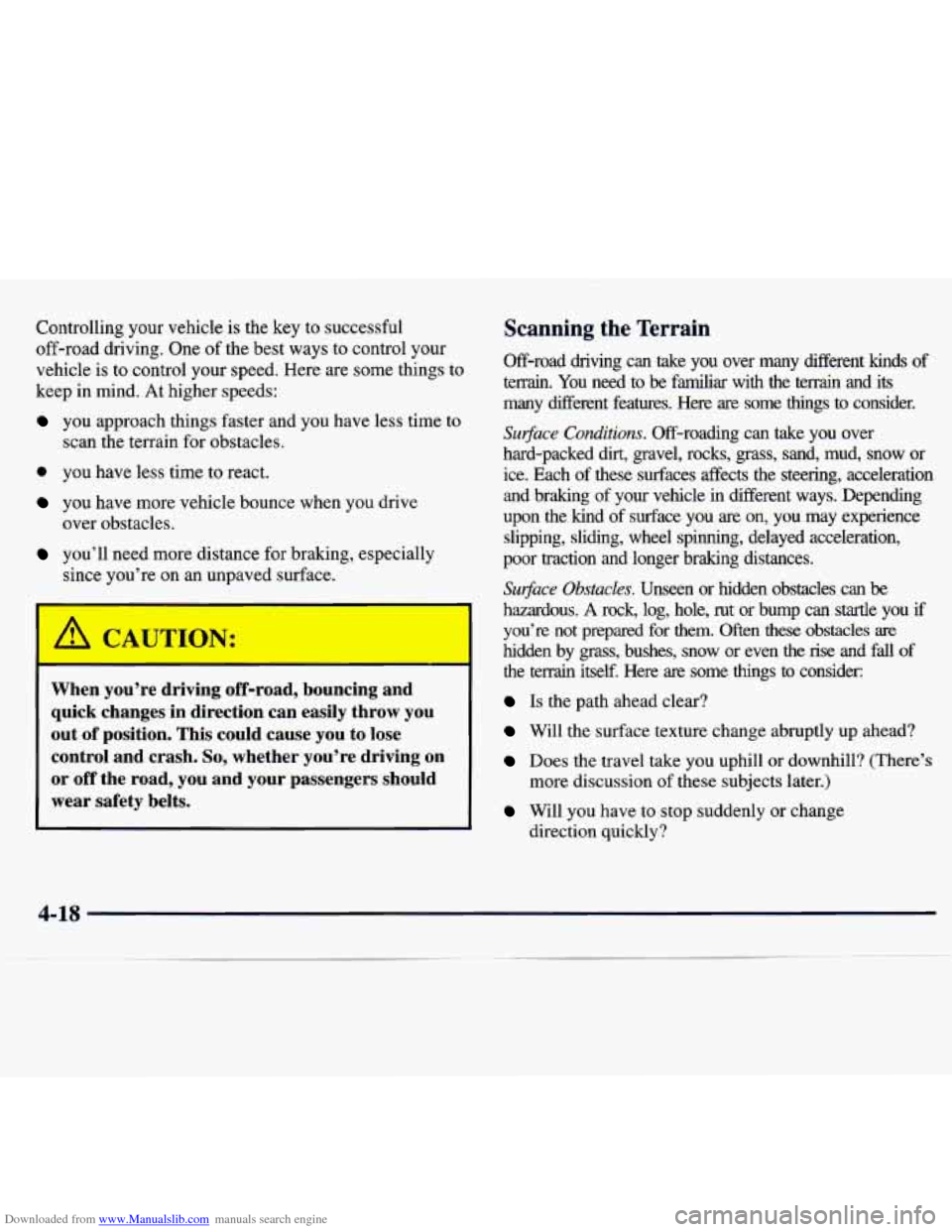
Downloaded from www.Manualslib.com manuals search engine Controlling your vehicle is the key to successful
off-road driving. One of the best ways to control your
vehicle is to control your speed. Here are some things to
keep in mind. At higher speeds:
you approach things faster and you have less time to
scan the terrain for obstacles.
0 you have less time to react.
you have more vehicle bounce when you drive
over obstacles.
you’ll need more distance for braking, especially
since you’re on an unpaved surface.
Scanning the Terrain
Off-road driving can take you over many different kinds of
terrain.
You need to be familiar with the terrain and its
many different features. Here are some things to consider.
Surfiace Conditions. Off-roading can take you over
hard-packed dirt, gravel, rocks,
grass, sand, mud, snow or
ice. Each
of these surfaces affects the steering, acceleration
and braking of
your vehicle in different ways. Depending
upon the kind of surface you are
on, you may experience
slipping, sliding, wheel spinning, delayed acceleration,
poor traction and longer braking distances.
Surface Obstacles. Unseen or hidden obstacles can be
hazardous. A rock, log, hole, rut or bump can startle you if
1 you’re not prepared for them. Often these obstacles are
hidden by grass, bushes, snow or even the rise and fall of
the terrain itself. Here are some things to consider:
Is the path ahead clear? When you’re driving off-road, bouncing and
quick changes in direction can easily throw you
out
of position. This could cause you to lose Will the surface texture change abruptly up ahead?
control and crash. So, whether you’re driving on Does the travel take you uphill or downhill? (There’s
or off the road, you and your passengers should more discussion of these subjects later.)
wear safety belts. Will you have to stop suddenly or change
direction quickly?
4-18
Page 189 of 386
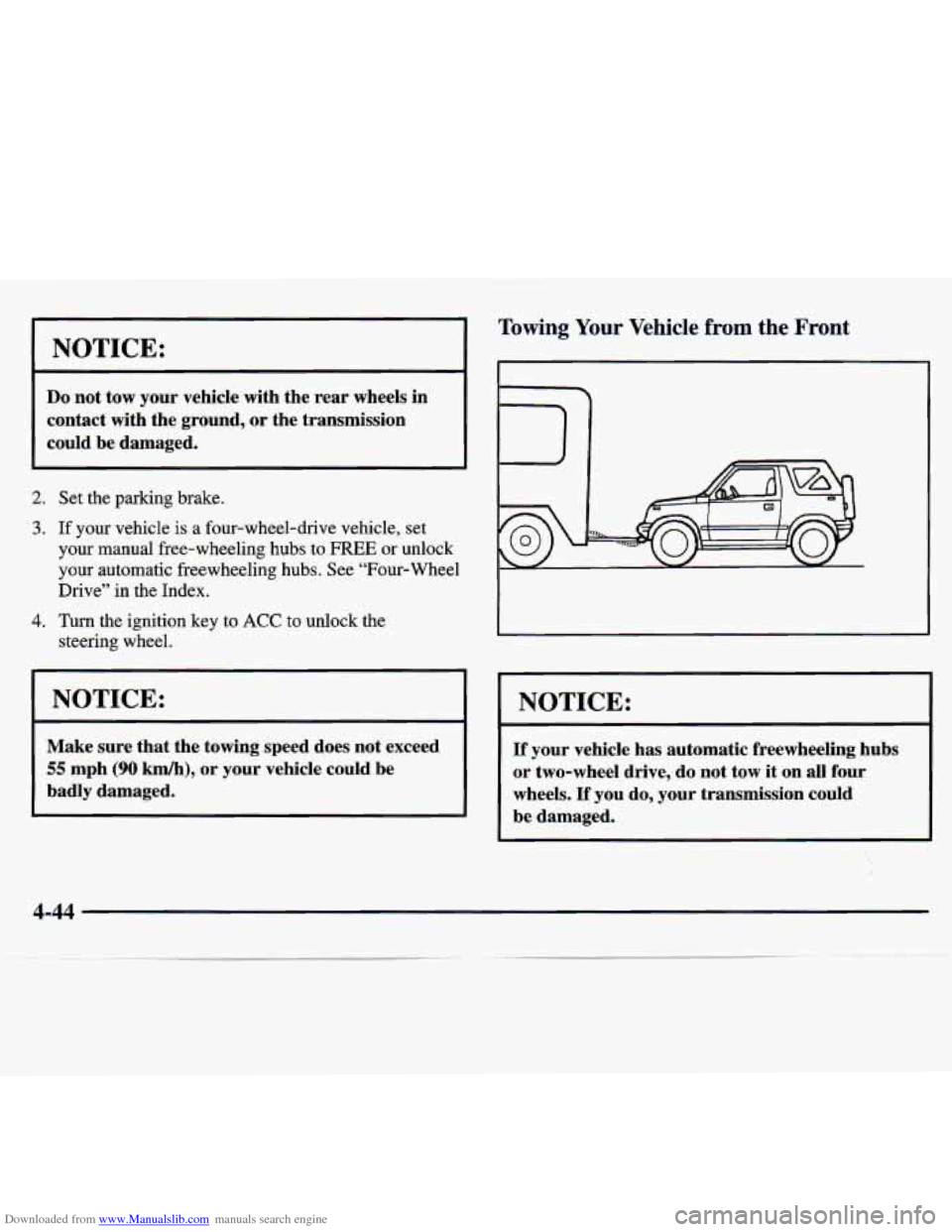
Downloaded from www.Manualslib.com manuals search engine NOTICE:
Do not tow your vehicle with the rear wheels in
contact with the ground,
or the transmission
could be damaged.
2. Set the parking brake.
3. If your vehicle is a four-wheel-drive vehicle, set
your manual free-wheeling hubs to
FREE or unlock
your automatic freewheeling hubs. See “Four- Wheel
Drive”
in the Index.
4. Turn the ignition key to ACC to unlock the
steering wheel.
NOTICE:
Make sure that the towing speed does not exceed
55 mph (90 km/h), or your vehicle could be
badly damaged.
Towil- - Your Vehicle from the Front
I
NOTICE:
If your vehicle has automatic freewheeling hubs
or two-wheel drive, do not tow it on all four
wheels.
If you do, your transmission could
be damaged.
4-44
Page 190 of 386
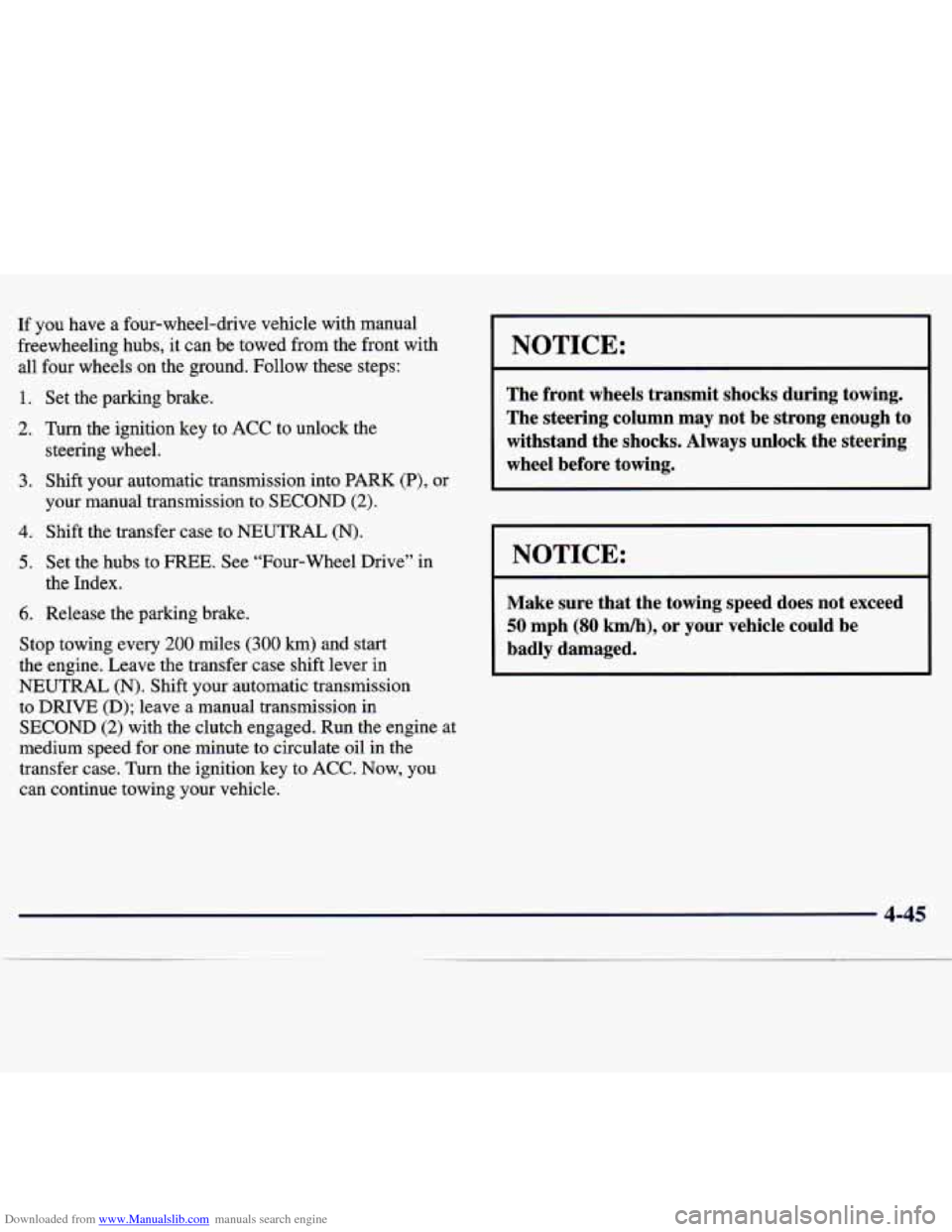
Downloaded from www.Manualslib.com manuals search engine If you have a four-wheel-drive vehicle with manual
freewheeling hubs,
it can be towed from the front with
all four wheels on the ground. Follow these steps:
1.
2.
3.
4.
5.
6.
Set the parking brake.
Turn the ignition key to ACC to unlock the
steering wheel.
Shift your automatic transmission into
PARK (P), or
your manual transmission to SECOND
(2).
Shift the transfer case to NEUTRAL (N).
Set the hubs to
FREE. See “Four-wheel Drive” in
the Index.
Release the parking brake.
Stop towing every
200 miles (300 km) and start
the engine. Leave the transfer case shift lever in
NEUTRAL (N). Shift your automatic transmission
to DRIVE (D); leave a manual transmission in
SECOND
(2) with the clutch engaged. Run the engine at
medium speed for one minute to circulate oil in the
transfer case.
Turn the ignition key to ACC. Now, you
can continue towing your vehicle.
NOTICE:
The front wheels transmit shocks during towing.
The steering column may not be strong enough to
withstand the shocks. Always unlock the steering
wheel before towing.
I NOTICE:
Make sure that the towing speed does not exceed
50 mph (80 km/h), or your vehicle could be
badly damaged.
4-45
Page 203 of 386

Downloaded from www.Manualslib.com manuals search engine Hazard Warning Flashers Press the button on top
of the steering column to
make your front and rear
turn signal lamps flash on and
off.
Your hazard warning flashers work no matter what
position your key is in, and even if the key isn’t in.
To turn off the flashers, push the button again.
When the hazard warning flashers are on, your turn signals won’t work.
Other Warning Devices
If you carry reflective triangles, you can set one up
at the side of the road about
300 feet (100 m) behind
your vehicle.
Your hazard warning flashers let you warn others. They
also let police know you have a problem. Your front and
rear turn signal lamps will flash on and
off.
5-2
Page 210 of 386
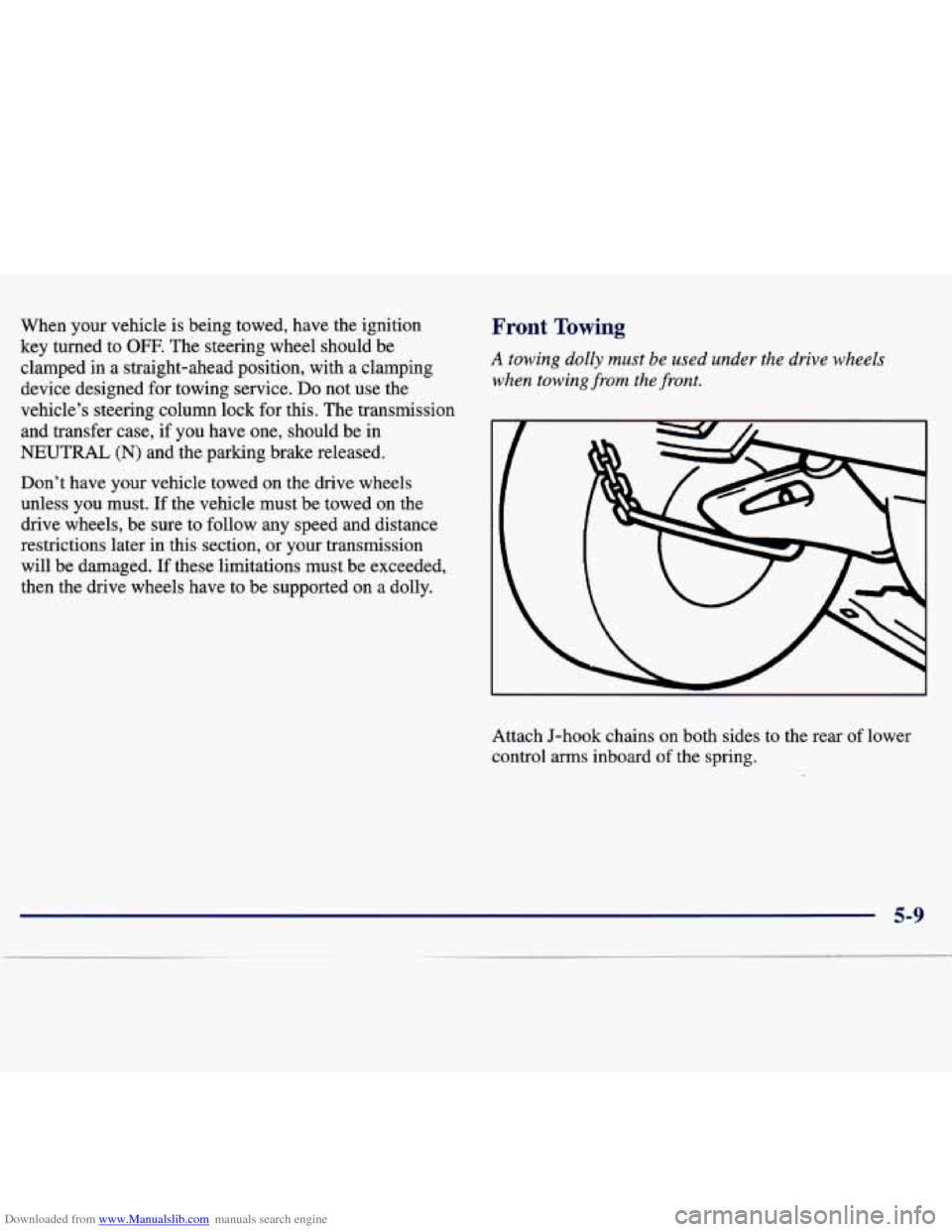
Downloaded from www.Manualslib.com manuals search engine When your vehicle is being towed, have the ignition
key turned to OFF. The steering wheel should be
clamped
in a straight-ahead position, with a clamping
device designed for towing service.
Do not use the
vehicle’s steering column lock for this. The transmission
and transfer case, if
you have one, should be in
NEUTRAL (N) and the parking brake released.
Don’t have your vehicle towed on the drive wheels
unless you must.
If the vehicle must be towed on the
drive wheels, be sure to follow any speed and distance
restrictions later in this section, or
your transmission
will be damaged. If these limitations must be exceeded,
then the drive wheels have to be supported on a dolly.
Front Towing
A towing dolly must be used under the drive wheels
when towing from the front.
Attach J-hook chains on both sides to the rear of lower
control arms inboard
of the spring.
5-9